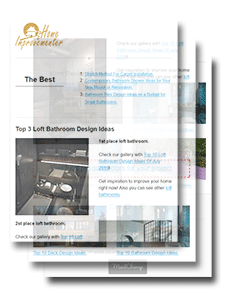Portobello
Posted on September 4, 2010
As in all the other sectors of the company, Portobello also concerns itself with the quality in each step of the production process, from the preparation of the material that forms the ceramic coverings to the dispatching of the finished products.
The Steps
1. Preparing the Material
The materials used in the industrial process – from our own deposits or from other suppliers – are stocked inside the production plant. The proportion of each raw material used is calculated by a percentage formula supplied by a laboratory, based on results obtained from tests. The raw material is then transported by conveyer belts to mills. After the grinding, the product is stored in holding tanks. Afterwards, the material is blasted with an atomizer, which removes excess water and leaves the humid and granulated atomized powder (a distribution of granules that facilitates compaction) uniformly, perfect for compressing.
2. Pressing and preparing the material
The atomized powder is feed into the cavities of a press and submitted to a specific pressure, having its definitive form named as “biscuit”.
3. Drying
Drying is a very important phase in the process of manufacturing floor and wall ceramic tiles. The aim is to eliminate almost all of the water contained in the pieces after the press process.
4. Glazing
It can be said that the final quality of the product depends on the care taken with the glazing. Quality also depends on processes before and after the glazing, which should follow pre-established standards and norms. To successfully carry out the glazing process, we must follow some steps to guarantee the quality of the product: post-drying, water application, engobe application, glaze application and serigraphic decoration.
5. Firing
After the glazing process, the product moves on to a kiln, where the piece is fired. The product acquires its final characteristics in the kiln, such as high mechanical resistance, high abrasion resistance and low water absorption. Apart from this, it is after firing that certain colors are obtained.
6. Selection
On leaving each kiln, each piece passes down an automatic selection line. On that line, the superficial defects are visually spotted by an employee while size and shape defects are automatically detected by electronic equipment. After the selection and classification process, the pieces are boxed, marked by brand and class, placed on pallets and then taken to the dispatch area.
7. Preparing glazes and tints
In the preparation of glazes and tints, the grinding is carried out using water. The mill is covered by high density alumina bricks, as are the grinding elements (spheres), thus providing high efficiency grinding. The glazes are applied on ceramic pieces for diverse objectives: waterproof, enhance appearance, to increase resistance to wear and chemical attack as well as mechanical resistance.
8. Quality control
Quality control permeates throughout the entire production process and its function is to monitor all phases, from the control of the raw material right through to the final product, when inspections of production samples take place to provide a statistical quality control. Final production lots are only released for Dispatch after being approved by CQPA – an acronym for Quality Control of Finished Products.
9. Dispatch
Carries out a physical stock control of finished products – entering and leaving. Controls the movement and transfer from the stock to facilitate the separation process, the storing, and the sending of products to the internal and external market, thus guaranteeing the quality of the service and the delivery to the client.
Official website: www.portobello.com.br

You will receive:
- Top Ten Design Ideas In Different Rooms.
- Tips and Trick to Use in Your Room Decoration.
- DIY Design Projects.
 100% Anti-Spam Protection
100% Anti-Spam Protection
ADD A COMMENT